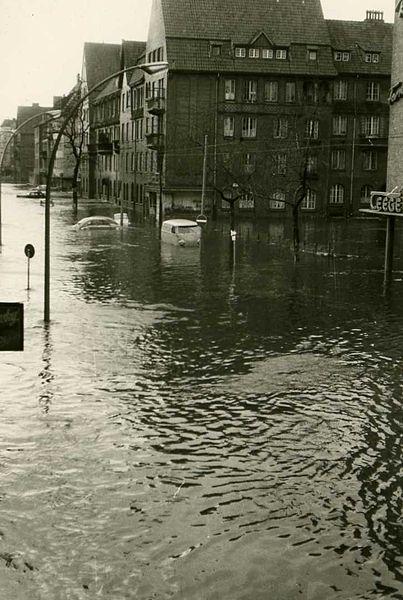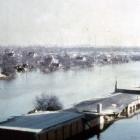On the night of the 16th and 17th of February 1962, a powerful flood spilled over Hamburg. Storm front Vincinette had swept over the north German coast and pushed enormous amounts of water into the mouth of the Elbe, thrusting a flood wave of 5.7 meters above sea level towards the city’s flood protection systems. Around midnight, the Elbe broke through the dyke system at sixty locations.

Photo of flooded city of Hamburg at Wilhelmsburg in 1962
Photo of flooded city of Hamburg at Wilhelmsburg in 1962
1962 Gerhard Pietsch
Click here to view Wikimedia source.
 This work is licensed under a Creative Commons Attribution-NonCommercial-ShareAlike 3.0 Unported License.
This work is licensed under a Creative Commons Attribution-NonCommercial-ShareAlike 3.0 Unported License.
Almost one-fifth of the municipal areas (12,500 ha) reported “submerged land.” Most affected were the southern parts of the city, which included the densely populated borough of Wilhelmsburg, whose residents were the bulk of the city’s flood victims. Aside from thousands of farm animals and pets, a total of 315 people in Hamburg and another 35 in the rest of northern Germany died in the catastrophe.

Flooded crossroad in Wilhelmsburg, 1962
Flooded crossroad in Wilhelmsburg, 1962
Photo: Gerhard Pietsch
Click here to view Wikimedia source.
 This work is licensed under a Creative Commons Public Domain Mark 1.0 License.
This work is licensed under a Creative Commons Public Domain Mark 1.0 License.
The flood hit Hamburg completely unexpectedly. The city’s infrastructure collapsed almost entirely, so many residents could not leave the flooded areas without assistance. An unprecedented rescue operation was deployed. Aside from the fire department and the Red Cross, Hamburg’s minister of the interior (and Germany’s future chancellor), Helmut Schmidt, recruited the German armed forces and international volunteers solicited by NATO to help with the rescue operations. Around 26,000 helpers entered the disaster area in inflatable dinghies and helicopters, successfully evacuating some ten thousand residents and accommodating them in emergency shelters. Given the success of the crisis management, both Helmut Schmidt and the newly structured German army garnered widespread public recognition. For the German armed forces, this was their first humanitarian relief effort on German soil.
The shock surrounding the flood and its victims and the now apparent fragility of security measures led to a turning point in coastal protection and disaster preparedness. The first steps forward included the planning and construction of new flood protection installations, increasing the height and strength of old dykes, and the establishment of a contingency plan for disasters. Despite the numerous, similarly serious floods that have followed (among them, those in 1976, 1981, and, most recently, 2007), no comparable disaster has struck the North Sea coast since 1962.

Flooded harbor area in Hamburg on February 17, 1962
Flooded harbor area in Hamburg on February 17, 1962
2012 Oxfordian
Click here to view Flickr source.
 This work is licensed under a Creative Commons Attribution-NoDerivs 2.0 Generic License.
This work is licensed under a Creative Commons Attribution-NoDerivs 2.0 Generic License.
How to cite
Mauch, Felix. “The Great Flood of 1962 in Hamburg.” Environment & Society Portal, Arcadia (2012), no. 6. Rachel Carson Center for Environment and Society. https://doi.org/10.5282/rcc/3733.
ISSN 2199-3408
Environment & Society Portal, Arcadia
 This work is licensed under a Creative Commons Attribution-NonCommercial-ShareAlike 3.0 Unported License.
This work is licensed under a Creative Commons Attribution-NonCommercial-ShareAlike 3.0 Unported License.
2012 Felix Mauch
This refers only to the text and does not include any image rights.
Please click on the images to view their individual rights status.
- Engels, Jens Ivo. “Vom Subjekt zum Objekt. Naturbild und Naturkatastrophen in der Geschichte der Bundesrepublik Deutschland.” In Naturkatastrophen. Beiträge zu ihrer Bedeutung, Wahrnehmung und Darstellung in Text und Bild von der Antike bis ins 20. Jahrhundert, edited by Dieter Groh, Michael Kempe, and Franz Mauelshagen, 119–142. Tübingen: Narr, 2003.
- Görtemaker, Manfred. Geschichte der Bundesrepublik Deutschland: Von der Gründung bis zur Gegenwart. Frankfurt am Main: Fischer, 2004.
- Hötte, Herbert, ed. Die Große Flut: Katastrophe, Herausforderung, Perspektiven. Hamburg: Landeszentrale für politische Bildung, 2012.
- Schott, Dieter. “One City—Three Catastrophes: Hamburg from the Great Fire 1842 to the Great Flood 1962.” In Cities and Catastrophes / Villes et catastrophes: Coping with Emergency in European History / Réactions face à l'urgence dans l'histoire européenne, edited by Geneviève Massard-Guildbaud, 185–204. Frankfurt am Main: Peter Lang, 2002.
- Vale, Lawrence, and Thomas Campanella, eds. The Resilient City: How Modern Cities Recover From Disaster. Oxford: University Press, 2005.








